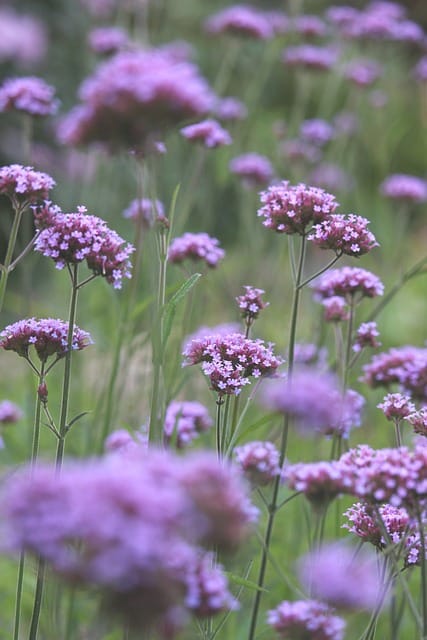How to grow Verbenas
The Verbenas flower is a beautiful and versatile plant that can bring color and vibrancy to any garden or landscape

In this article:
- Introduction
- Choosing the right variety of Verbenas
- Selecting the ideal location
- Preparing the soil
- Planting Verbenas
- Watering and fertilizing
- Pruning and pinching back
- Controlling pests and diseases
- Overwintering Verbenas
- Propagation methods
- Companion planting with Verbenas
- Creating a Verbenas flower bed or container garden
- Tips for maintaining healthy Verbenas
- Enjoying the blooms: Uses of Verbenas in arrangements and landscapes
- Conclusion
Introduction
The Verbenas flower is a beautiful and versatile plant that can bring color and vibrancy to any garden or landscape. With its long-lasting blooms and delicate fragrance, Verbenas are a popular choice for both experienced and novice gardeners. In this article, we will explore the steps to successfully grow Verbenas and enjoy their stunning displays of flowers.
Choosing the right variety of Verbenas
There are numerous varieties of Verbenas to choose from, each with its own unique characteristics. When selecting a variety, consider factors such as color preferences, plant height, and growth habits. Some popular varieties include 'Homestead Purple', 'Tapien', and 'Lollipop'.
Selecting the ideal location
Verbenas thrive in full sun, so choose a location that receives at least six hours of direct sunlight per day. Ensure the area has well-draining soil to prevent waterlogging, as this can lead to root rot and other issues.
Preparing the soil
Before planting Verbenas, it is vital to prepare the soil. Start by removing any weeds or grass from the planting area. Loosen the soil using a garden fork or tiller, and mix in organic matter such as compost or well-rotted manure to improve drainage and fertility.
Planting Verbenas
When planting Verbenas, space them at least 12 inches apart to allow for proper air circulation and growth. Dig holes that are slightly larger than the root ball of the plants, and gently place them in the holes. Backfill with soil, firming it gently around the roots.
Watering and fertilizing
Proper watering is crucial for the health of Verbenas. Water regularly, aiming to keep the soil evenly moist but not waterlogged. Avoid overhead watering, as wet foliage can increase the risk of diseases. Apply a balanced fertilizer every four to six weeks during the growing season to promote healthy growth and abundant blooms.
Pruning and pinching back
To encourage bushier growth and more flowers, regularly pinch back the tips of the Verbenas. This can be done by using clean shears to remove around one-third of the stem length. Light pruning after each bloom cycle can also keep the plant tidy and promote new growth.
Controlling pests and diseases
Verbenas are generally resistant to most pests and diseases. However, keep an eye out for common issues such as aphids, whiteflies, and powdery mildew. If necessary, use organic pest control methods such as neem oil or insecticidal soap to combat these problems.
Overwintering Verbenas
In regions with harsh winters, Verbenas may not survive outdoors. To overwinter them, dig up the plants before the first frost and transfer them to pots. Place the pots in a cool, dark area where the temperature remains above freezing. Water sparingly during the dormant period to prevent the roots from drying out.
Propagation methods
There are several ways to propagate Verbenas, including from seeds, stem cuttings, or by dividing established plants. Each method has its advantages, and the choice depends on personal preference and the availability of resources.
Companion planting with Verbenas
Verbenas can be an excellent addition to various companion plantings. Their vibrant flowers and attractive foliage complement many other plants, such as Salvia, Echinacea, and Gaura. Consider the color and height compatibility when selecting companions to create an aesthetically pleasing and harmonious arrangement.
Creating a Verbenas flower bed or container garden
Verbenas can be grown in both flower beds and containers. When designing a flower bed or container garden, consider the overall theme, color scheme, and plant height to create a visually appealing display. Mix different varieties of Verbenas and combine them with other compatible plants for a stunning arrangement.
Tips for maintaining healthy Verbenas
To ensure healthy Verbenas, regularly inspect the plants for signs of pests or diseases. Remove spent flowers to promote continuous blooming. Monitor the soil moisture levels, adjusting the watering as necessary. Apply an organic mulch around the plants to retain moisture, suppress weeds, and regulate soil temperature.
Enjoying the blooms: Uses of Verbenas in arrangements and landscapes
Verbenas are versatile plants that can be used in various ways. Their attractive blooms make them a popular choice for floral arrangements, both fresh and dried. In landscapes, Verbenas can be used as borders, ground covers, or in mixed plantings to add color and texture.
Conclusion
By following the steps outlined in this article, you can successfully grow Verbenas and enjoy their vibrant flowers throughout the growing season. With proper care and attention, Verbenas can bring charm and beauty to any garden or landscape, making them a rewarding choice for gardeners of all levels of experience.
